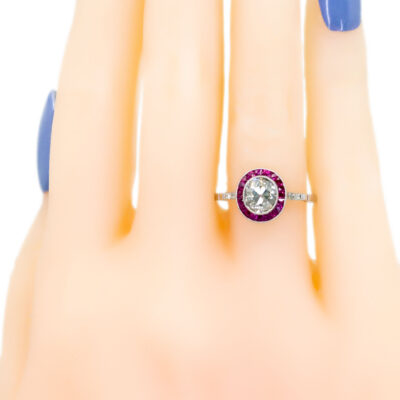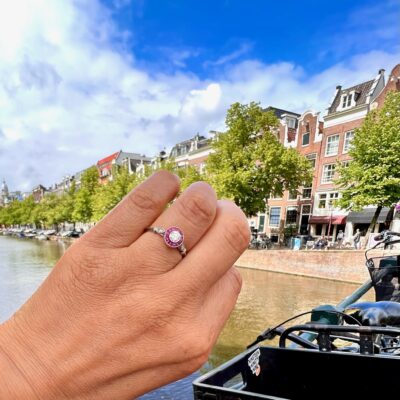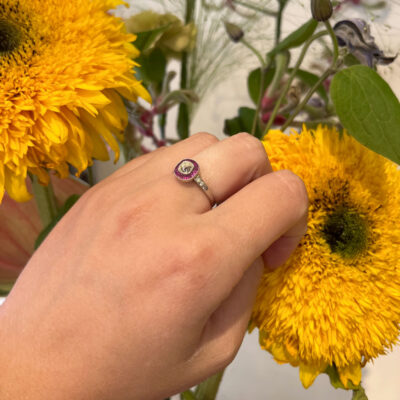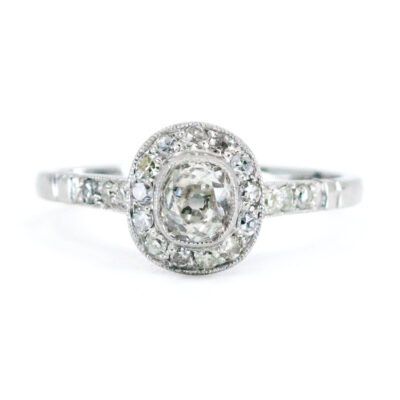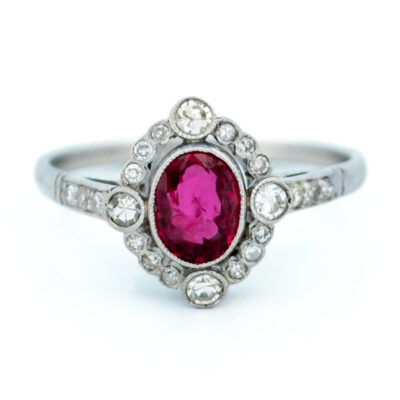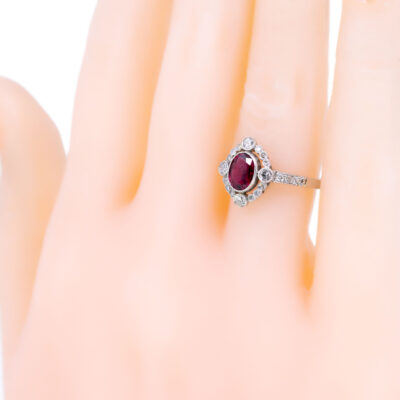Immerse yourself in luxury with our Binenbaum Revival Halo Ring. At its core lies a 0.70 carat old-European-cut diamond, graded J VS1, framed by a vivid halo of French-cut rubies. The Platinum band is adorned with hand-picked diamond accents, elevating its sophistication. ✨🔴
Videos
Details: ±0,70ct (J VS1) Old-european-cut diamond, Rubies, Diamonds, Platinum Ring.
Design Era: Binenbaum Vintage Revivals.
Size: 17.12 NL / 53.8 FR / 6¾ US / N UK, sizeable (Within reason. Contact seller for information).
Dimensions: D: 10 x 10 mm.
Weight in grams: 2,5.
Condition: Excellent condition – barely used with minimal signs of wear.
Shipping and Pickup: This gorgeous piece ships from our store located in the center of Amsterdam, The Netherlands. We offer both registered shipping and local pickup at our store. In the case of local pickup, any applicable shipping costs will be refunded.
About Us: Add some sparkle to your style with Binenbaum.com. We offer a stunning selection of antique and vintage jewelry that you won’t find anywhere else. From timeless rings and dazzling necklaces to unique brooches, we have something for every taste and occasion. Visit our website today and treat yourself to a piece of history.
| Design Era | |
|---|---|
| Design & Historical Context | At Binenbaum, our 40-year legacy, dating back to the early '80s, is more than just selling jewelry; it's about crafting timeless pieces that blend history with modern quality. Introducing our latest creation: Binenbaum Vintage Revivals. This unique collection draws inspiration from historic eras like Art Deco and Victorian to create contemporary designs that resonate with timeless elegance. But what truly sets Binenbaum Vintage Revivals apart is our commitment to sustainable luxury. We don't just mimic vintage styles; we revitalize and repurpose antique jewelry, ensuring each piece is both enduring and exquisite. In doing so, we infuse our personal touch into every creation, making each item a tribute to the rich history of jewelry and a story yet to be told. |
| Key Materials | |
| Materials & Craftsmanship | Old-european-cut diamond: The Vintage Sparkle of Classic Romance Old European-cut diamonds are a beloved choice for those who appreciate vintage elegance and timeless beauty. This diamond cut, which was predominant from the late 19th century through the early 20th century, is known for its round shape, high crown, small table, and large, open culet. These characteristics give the stone a soft, romantic sparkle that evokes the charm of a bygone era. Historically, the Old European cut was the precursor to the modern round brilliant cut. It was crafted by hand, with each facet carefully shaped to maximize the diamond's brilliance under the softer lighting conditions of the time, such as candlelight. This cut was popular during the Victorian, Edwardian, and Art Deco periods, making it a favorite in antique and vintage jewelry. In modern jewelry, Old European-cut diamonds are highly sought after for their unique sparkle and historical significance. They often exhibit a warmer, more subdued brilliance compared to modern cuts, with an emphasis on depth and fire rather than the bright flashes of light seen in contemporary diamonds. This makes them ideal for engagement rings, earrings, and other pieces that celebrate vintage style and craftsmanship. An Old European-cut diamond is more than just a gemstone; it is a piece of history, reflecting the elegance and romance of the past. Its distinctive charm and enduring beauty make it a perfect choice for those who appreciate the artistry and nostalgia of vintage jewelry. Ruby: The Gem of Passion and Nobility Ruby, with its fiery red color, is one of the most coveted gemstones in the world, symbolizing passion, power, and nobility. This precious gem belongs to the corundum family, with its striking red hue derived from trace amounts of chromium. Rubies can range in color from deep crimson to vibrant red, often referred to as pigeon’s blood, the most prized shade. Throughout history, rubies have been revered as symbols of wealth and power. In ancient India, they were called the king of gemstones and were believed to protect warriors in battle. In medieval Europe, rubies were thought to bring good fortune, enhance love, and maintain health. Royals and aristocrats adorned themselves with rubies to signify their status and strength. In modern jewelry, rubies are celebrated for their durability and brilliance, with a Mohs hardness of 9, second only to diamonds. This makes them ideal for rings, necklaces, earrings, and other pieces designed for everyday wear. Rubies are often set in gold or platinum, where their vibrant color is showcased to its full potential, adding a touch of luxury and elegance to any design. Ruby is more than just a gemstone; it is a symbol of intense emotion, passion, and enduring strength. Its rich color and historical significance make it a timeless and powerful choice for jewelry that speaks of love, courage, and grandeur. Diamond: The Ultimate Symbol of Purity and Strength Diamond, the hardest natural material on Earth, is celebrated for its unmatched brilliance and durability. Composed of pure carbon, diamonds are formed under extreme pressure and heat deep within the Earth’s mantle over billions of years, making them a true marvel of nature. Throughout history, diamonds have been revered as symbols of purity, power, and eternal love. Ancient cultures believed diamonds were fragments of stars or tears of the gods, and they have long been associated with invincibility and protection. In the world of jewelry, diamonds are the ultimate gemstone, known for their exceptional sparkle and ability to reflect light like no other material. Their hardness, rated at 10 on the Mohs scale, ensures they remain unscathed and brilliant even with everyday wear. This makes diamonds the perfect choice for engagement rings, earrings, and other pieces meant to last a lifetime. Beyond their physical beauty, diamonds carry deep symbolism, representing unbreakable bonds, clarity, and inner strength. Whether set in classic or contemporary designs, diamonds remain the epitome of elegance and luxury in jewelry. Platinum: The Metal of Endurance and Prestige Platinum, a rare and precious metal, is renowned for its exceptional strength, purity, and enduring beauty. With its naturally white luster and remarkable resistance to tarnish and corrosion, platinum has become synonymous with luxury and durability in the world of fine jewelry. Historically, platinum has been valued for its rarity and unique properties. Ancient Egyptians and Pre-Columbian civilizations used platinum in their ceremonial jewelry, though its full potential wasn’t realized until the 18th century. By the 20th century, platinum became the metal of choice for royalty and high society, particularly in engagement rings and fine jewelry, due to its ability to securely hold precious gemstones. In modern jewelry, platinum is highly prized for its hypoallergenic properties and its ability to withstand daily wear without losing its brilliance. Its density and weight give it a luxurious feel, while its purity—often 95% pure—makes it an ideal setting for diamonds and other gemstones. Platinum's naturally white sheen enhances the sparkle of gems, and its durability ensures that jewelry pieces crafted in platinum can be passed down through generations. Platinum is more than just a metal; it is a symbol of strength, rarity, and timeless elegance. Its unmatched durability and sophisticated appearance make it the ultimate choice for those seeking jewelry that lasts a lifetime while maintaining its prestige and beauty. |
| Size | |
| Dimensions | D: 10 x 10 mm |
| Gender | |
| Weight (in grams) | 2,5 |
| Condition | Excellent condition – barely used with minimal signs of wear |
By following these tips, you can enjoy your precious jewelry for many years to come.
Related Products
-
Diamond Ruby Platinum Halo Ring 1740-4476
€ 4.595,00 VAT incl. (where applicable) -
Binenbaum Luxe Halo Ring 6966-1885
€ 5.495,00 VAT incl. (where applicable) -
Diamond Ruby Platinum Halo Ring 5830-1830
€ 4.595,00 VAT incl. (where applicable) -
Diamond Platinum Ruby Platinum Halo Ring 2814-6190
€ 2.495,00 VAT incl. (where applicable) -
Diamond Ruby Platinum Halo Ring 8951-6188
€ 3.895,00 VAT incl. (where applicable) -
Diamond Emerald Platinum Halo Ring 12767-5039
€ 3.995,00 VAT incl. (where applicable) -
Diamond Platinum Halo Ring 10481-4990
€ 3.395,00 VAT incl. (where applicable) -
Diamond Ruby Platinum Quatrefoil Ring 13718-5101
€ 3.995,00 VAT incl. (where applicable)
- Home
- Collection
- Fine Jewelry
- Silver Jewelry
- Silverware
- Boxes
- Candlesticks
- Salt and pepper shakers
- Miniatures
- Salt cellars
- Spoon Set
- Condiments
- Frames
- Napkin Ring
- Spoon
- Oddities
- Cups
- Vases
- Cutlery
- Serving Spoon And Cake Server
- Candlesticks
- Baskets
- Hanukkiah
- Spice Tower
- Yad
- Tea Set
- Sugar Castor
- Napkin Rings
- Wine Bottle Coaster
- Wine Stopper
- Tea Pot
- Jugs
- Rattles
- Hip Flask
- Miscellaneous
- Rings 💍
- About
- Contact








